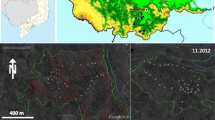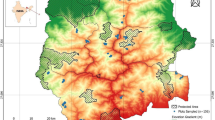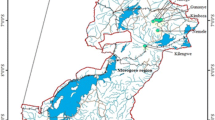Abstract
A quantitative inventory of trees and lianas was conducted (1) to compare floristic composition, diversity and stem density variation between three different forest types (tierra firme, floodplain and swamp), and (2) to analyse the relationships between floristic similarity and forest structure in two regions ~60 km apart in Yasuní National Park, Amazonian Ecuador. A total of 1,087 species with a diameter at breast height ≥ 2.5 cm were recorded in 25 0.1-ha plots. Tierra firme was the habitat with the highest number of species and stem density for trees and lianas, followed by floodplain and swamp in both regions. Two hypotheses that have been independently proposed to describe plant distribution in tropical rain forests, together explain species spatial distribution in this study. The fact that the 30 most important species per forest type (totalling 119 species) accounted for 48.2% of total individuals supports the oligarchy hypothesis. Likewise, 28 out of these 119 species are reported as restricted to a single forest type, which supports the environmental-determinism hypothesis. In general, both canopy and understorey trees and lianas showed rather similar floristic patterns across different forest types and regions.



Similar content being viewed by others
References
Balslev H, Luteyn J, Øllgaard B, Holm-Nielsen LB (1987) Composition and structure of adjacent unflooded and floodplain forest in Amazonian Ecuador. Opera Bot 92:37–57
Bass MS, Finer M, Jenkins CN et al (2010) Global conservation significance of Ecuador’s Yasuní National Park. PLoS ONE 5:e8767
Burnham RJ (2002) Dominance, diversity and distribution of lianas in Yasuní, Ecuador: who is on top? J Trop Ecol 18:845–864
Burnham RJ (2004) Alpha and beta diversity of lianas in Yasuní, Ecuador. For Ecol Manage 190:43–55
Campbell DG, Daly DC, Prance GT, Maciel UN (1986) Quantitative ecological inventory of terra firme and várzea tropical forest on the Rio Xingu, Brazilian Amazon. Brittonia 38:369–393
Campbell DG, Stone JL, Rosas A Jr (1992) A comparison of the phytosociology and dynamics of three floodplain (várzea) forests of known ages, Rio Juruá, western Brazilian Amazon. Bot J Linn Soc 108:213–237
Cerón CE (1997) Composición de una hectárea de bosque en la comunidad Huaorani de Quehueiri-Ono, zona de amortiguamiento del Parque Nacional Yasuní, Napo, Ecuador. In: Mena PA, Soldi A, Alarcón R et al (eds) Estudios biológicos para la conservación, diversidad, ecología y etnobiología. Ecociencia, Quito, pp 279–298
Condit R, Foster RB, Hubbell SP et al (1998) Assessing forest diversity on small plots: calibration using species-individual curves from 50-ha plots. In: Dallmeier F, Comiskey JA (eds) Forest biodiversity research, monitoring and modeling. UNESCO, Paris, pp 247–268
Curtis JT, McIntosh RP (1951) An upland forest continuum in the prairie-forest border region of Wisconsin. Ecology 32:476–496
Duivenvoorden JF (1994) Vascular plant species counts in the rain forests of the middle Caquetá area, Colombian Amazonia. Biodivers Conserv 3:685–715
Duque AJ, Sánchez M, Cavelier J, Duivenvoorden JF (2002) Different floristic patterns of woody understorey and canopy plants in Colombian Amazonia. J Trop Ecol 18:499–525
Ferreira LV (1997) Effects of the duration of flooding on species richness and floristic composition in three hectares in the Jaú National Park in floodplain forests in central Amazonia. Biodivers Conserv 6:1353–1363
Fine PVA, Daly DC, Villa G et al (2005) The contribution of edaphic heterogeneity to the evolution and diversity of Burseraceae trees in the western Amazon. Evolution 59:1464–1478
Fisher RA, Corbet AS, Williams CB (1943) The relation between the number of species and the number of individuals in a random sample of an animal population. J Anim Ecol 12:42–58
Gentry AH (1988) Changes in plant community diversity and floristic composition on environmental and geographical gradients. Ann Mo Bot Gard 75:1–34
Gentry AH (1993) A field guide to the families and genera of woody plants of northwest South America (Colombia, Ecuador, Peru). Conservation International, Washington
Gentry AH, Dodson C (1987) Contribution of nontrees to species richness of a tropical rain forest. Biotropica 19:149–156
Gerwing JJ, Schnitzer SA, Burnham RJ et al (2006) A standard protocol for liana censuses. Biotropica 38:256–261
Holmgren PK, Holmgren NH, Barnett LC (1990) Index Herbariorum, part I: the herbaria of the world, 8th edn. The New York Botanical Garden, New York
John R, Dalling JW, Harms KE et al (2007) Soil nutrients influence spatial distributions of tropical tree species. Proc Natl Acad Sci USA 104:864–869
Jørgensen PM, León-Yánez, S (eds) (1999) Catalogue of the vascular plants of Ecuador. Monogr Syst Bot Missouri Bot Gard 75:1–1181
Kahn F (1991) Palms as key swamp forest resources in Amazonia. For Ecol Manage 38:133–142
Legendre P, Legendre L (1998) Numerical ecology. Elsevier, Amsterdam
Lieberman L, Lieberman D, Hartshorn GS, Peralta R (1985) Small-scale altitudinal variation in lowland wet tropical forest vegetation. J Ecol 73:505–516
Macía MJ (2008) Woody plants diversity, floristic composition and land use history in the Amazonian rain forests of Madidi National Park, Bolivia. Biodivers Conserv 17:2671–2690
Macía MJ, Svenning JC (2005) Oligarchic dominance in western Amazonian plant communities. J Trop Ecol 21:613–626
Macía MJ, Ruokolainen K, Tuomisto H et al (2007) Congruence between floristic patterns of trees and lianas in a southwest Amazonian rain forest. Ecography 30:561–577
Malo G, Arguello C (1984) Proyecto Oriente-Mapa de compilación geológica de la provincia del Napo. Ministerio de Energía y Minas, Quito
Montúfar R, Pintaud JC (2006) Variation in species composition, abundance and microhabitat preferences among western Amazonian terra firme palm communities. Bot J Linn Soc 151:127–140
Mori SA, Boom BM, De Carvalho AM, Dos Santos TS (1983) Ecological importance of Myrtaceae in an eastern Brazilian wet forest. Biotropica 15:68–70
Nabe-Nielsen J (2001) Diversity and distribution of lianas in a neotropical rain forest, Yasuní National Park, Ecuador. J Trop Ecol 17:1–19
Nabe-Nielsen J, Hall P (2002) Environmentally induced clonal reproduction and life history traits of the liana Machaerium cuspidatum in an Amazonian rain forest, Ecuador. Plant Ecol 162:215–226
Pitman NCA, Terborgh JW, Silman MR et al (2001) Dominance and distribution of tree species in upper Amazonian terra firme forests. Ecology 82:2101–2117
Pitman NCA, Terborgh JW, Silman MR et al (2002) A comparison of tree species diversity in two upper Amazonian forests. Ecology 83:3210–3224
Punyasena SW, Eshel G, McElwain JC (2008) The influence of climate on the spatial patterning of Neotropical plant families. J Biogeogr 35:117–130
Queenborough SA, Burslem DFRP, Garwood NC, Valencia R (2007) Habitat niche partitioning by 16 species of Myristicaceae in Amazonian Ecuador. Plant Ecol 192:193–207
Romero-Saltos H, Valencia R, Macía MJ (2001) Patrones de diversidad, distribución y rareza de plantas leñosas en el Parque Nacional Yasuní y Reserva Étnica Huaorani, Amazonía ecuatoriana. In: Duivenvoorden JF, Balslev H, Cavelier J et al (eds) Evaluación de recursos vegetales no maderables en la Amazonía noroccidental. Universiteit van Amsterdam, Amsterdam, pp 131–162
Romoleroux K, Foster R, Valencia R et al (1997) Árboles y arbustos (dap ≥ 1 cm) encontrados en dos hectáreas de un bosque de la Amazonía ecuatoriana. In: Valencia R, Balslev H (eds) Estudios sobre diversidad y ecología de plantas. Universidad Católica del Ecuador, Quito, pp 189–215
Ruokolainen K, Tuomisto H, Macía MJ et al (2007) Are floristic and edaphic patterns in Amazonian rain forests congruent for trees, pteridophytes and Melastomataceae? J Trop Ecol 23:13–25
Shmida A, Wilson MV (1985) Biological determinants of species diversity. J Biogeogr 12:1–20
Svenning JC (1999) Microhabitat specialization in a species-rich palm community in Amazonian Ecuador. J Ecol 87:55–65
Terborgh J, Andresen E (1998) The composition of Amazonian forests: patterns at local and regional scales. J Trop Ecol 14:645–664
Tuomisto H, Ruokolainen K, Poulsen AD et al (2002) Distribution and diversity of Pteridophytes and Melastomataceae along edaphic gradients in Yasuní National Park, Ecuadorian Amazonia. Biotropica 34:516–533
Tuomisto H, Poulsen AD, Ruokolainen K et al (2003a) Linking floristic patterns with soil heterogeneity and satellite imagery in Ecuadorian Amazonia. Ecol Appl 13:352–371
Tuomisto H, Ruokolainen K, Yli-Halla M (2003b) Dispersal, environment, and floristic variation of western Amazonian forests. Science 299:241–244
Valencia R, Foster RB, Villa G et al (2004) Tree species distributions and local habitat variation in the Amazon: large forest plot in eastern Ecuador. J Ecol 92:214–229
Vormisto J, Svenning JC, Hall P, Balslev H (2004) Diversity and dominance in palm (Arecaceae) communities in terra firme forests in western Amazon basin. J Ecol 92:577–588
Acknowledgements
I gratefully acknowledge to the staff of Herbario QCA and Yasuní Research Station for work facilities, H. Romero, R. Montúfar and C. Vélez for help during fieldwork, J. Santiana for herbarium processing, R. Valencia and J. Duivenvoorden for project assistance, K. Ruokolainen for statistical recommendations, A. Ibáñez, N. Pitman and three anonymous reviewers for helpful comments on the manuscript. This study was funded by European Union (INCO-DC, IC18-CT960038).
Author information
Authors and Affiliations
Corresponding author
Rights and permissions
About this article
Cite this article
Macía, M.J. Spatial distribution and floristic composition of trees and lianas in different forest types of an Amazonian rainforest. Plant Ecol 212, 1159–1177 (2011). https://doi.org/10.1007/s11258-011-9895-1
Received:
Accepted:
Published:
Issue Date:
DOI: https://doi.org/10.1007/s11258-011-9895-1




